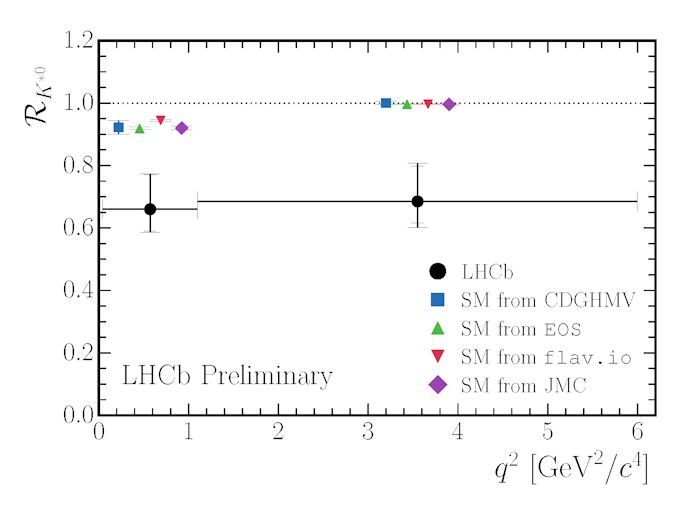Cracks in the (Lepton) Family Structure?

Image: The image shows the new measured value of RK*0 (ratio of di-muon production to electron positron production) in two regions of the μ+μ- or e+e- invariant mass squared, q2. A previous LHCb measurement of the quantity RK in which the B0 meson is replaced by a B+ and the K*0 meson by a K+ in the ratio, was also found to have a similar value and be lower than unity by 2.6 standard deviations
For the last 80 years we have known that atoms are made of a nucleus of protons and neutrons, and electrons which orbit them. Liverpool’s Sir James Chadwick received the Nobel Prize for the discovery of the neutron. The electrons are very light, point-like particles and their properties are very well known – as they should be – as they play a huge role in the physics of solids, chemistry and electronics. However, electrons are not alone. They share many of their properties with particles called muons, originally detected in cosmic radiation. Muons are point-like, charged but almost 200 times heavier than an electron, although still 10 times lighter than a proton. Both electrons and muons are part of a family of particles called the charged leptons, of which there are three types or generations. All are believed to have almost identical properties, barring their mass. This idea is called lepton universality. It is a cornerstone of our understanding of the subatomic world, embedded in the Standard Model, our theory of Particle Physics.
The LHCb experiment at CERN has been undertaking one of the most detailed studies to date of lepton universality. In a presentation given this week at CERN , the collaboration presented some of their first results. The LHCb experiment was built to study beauty, or to be more precise particles called beauty mesons. LHCb produces more than a thousand billion mesons per year that contain both a “beauty” quark and an “down” quark (known as a B meson). These particles are not stable and decay in less than a millionth of a millionth of second. Some of the decays result are to "strange" particles (kaons – containing a "strange" quark) and to pairs of leptons (electrons and anti-electrons, or muons and anti-muons). According to the Standard Model, a B meson should decay to a kaon, electron and positron as often as it decays to a kaon, muon and antimuon. Measuring the relative number of B decays to a kaon + electrons compared to a kaon + muons is a direct test of lepton universality, and hence the Standard Model.
With its precision silicon tracker ( built by Liverpool’s Particle Physics Group which allows B decays to be identified) LHCb is first in the queue to further explore the B+ meson system, and push the bounds of our understanding of lepton universality.
LHCb has now analysed their entire Run-1 dataset of proton-proton collisions from the LHC and finds that B mesons decay to kaons and muons slightly less often than they decay to kaons and electrons. As these decays only occur a couple of times in every 10 million B decays the measurement is still dominated by statistical error, even if it is the world’s most precise determination. The observed divergence has a chance of one in a hundred that it is due to a statistical fluctuation. This is a long way away from being a discovery, but tantalizing and important enough to keep measuring. More data from the forthcoming high energy LHC run will be used to confirm if this result is indeed the first sign of something new in the universe.
Professor Tara Shears, who leads the LHCb group at Liverpool said “This is an important new avenue of research for the experiment and emphasises that we leave no stone unturned in testing the Standard Model to its limits. The Liverpool built VELO is potentially a key component in uncovering new physics, and the upgraded VELO that we're now working on will ensure we can continue this search in the future."
Interest in the possibility of lepton universality violation has grown over the last decade. Themis Bowcock, who leads the Particle Physics group comments “A new generation of experiments at CERN and Fermilab is being undertaken by the Liverpool group to measuring the properties of the charged leptons where new physics may reside. This would add to our extensive neutral lepton (neutrino) programme which has already delivered evidence of new physics through neutrino oscillations. Lepton families are much more complex than we ever imagined, and could open the door to the new types physics beyond our Standard Model description.”
